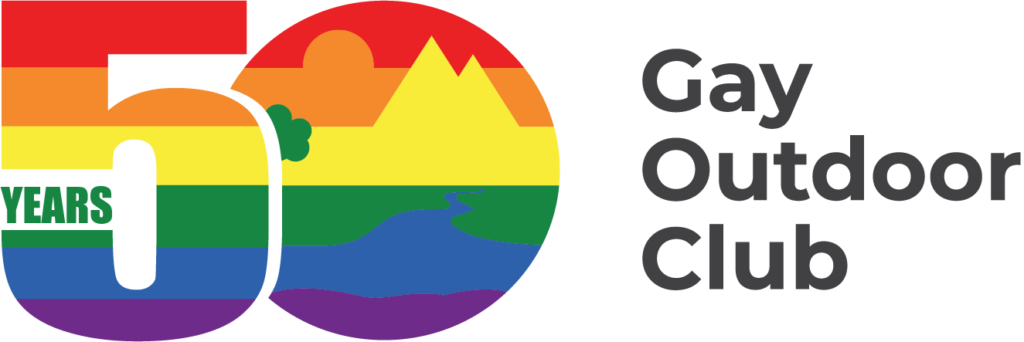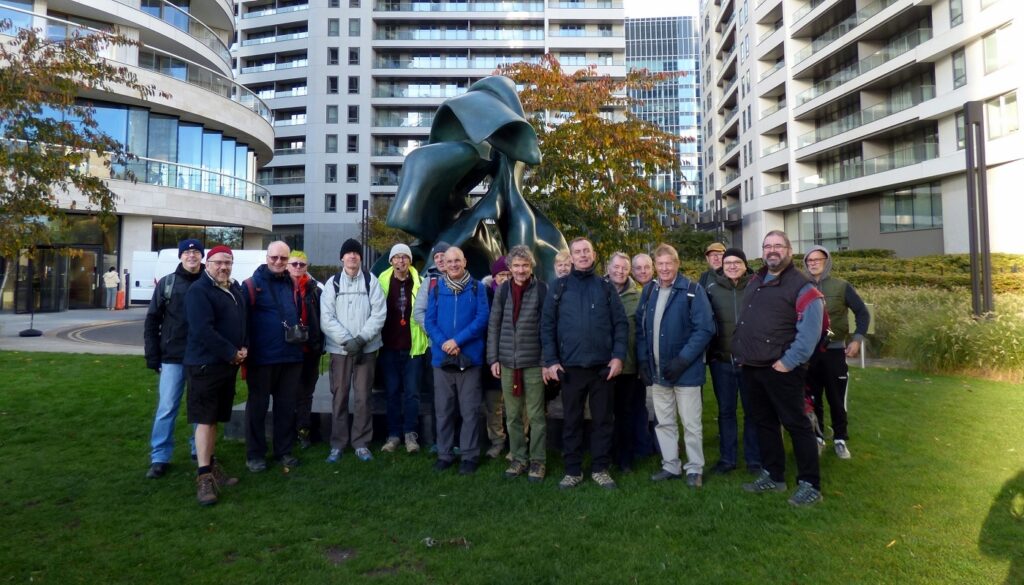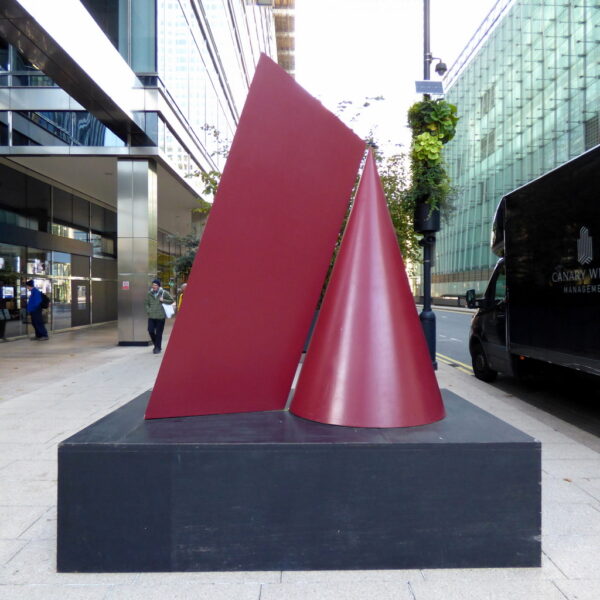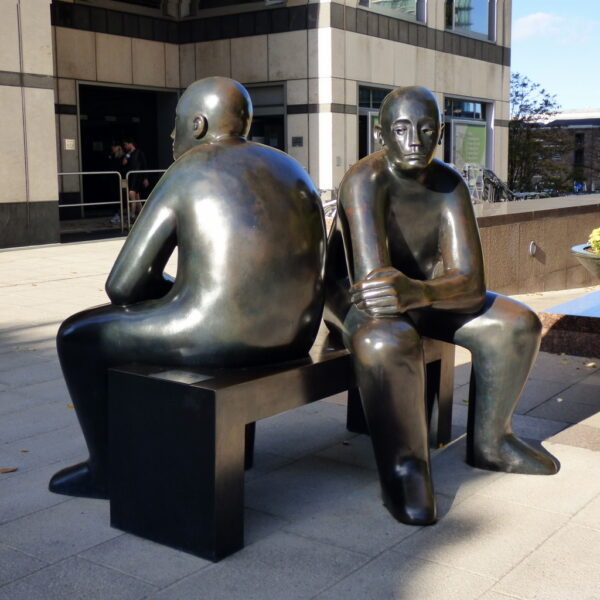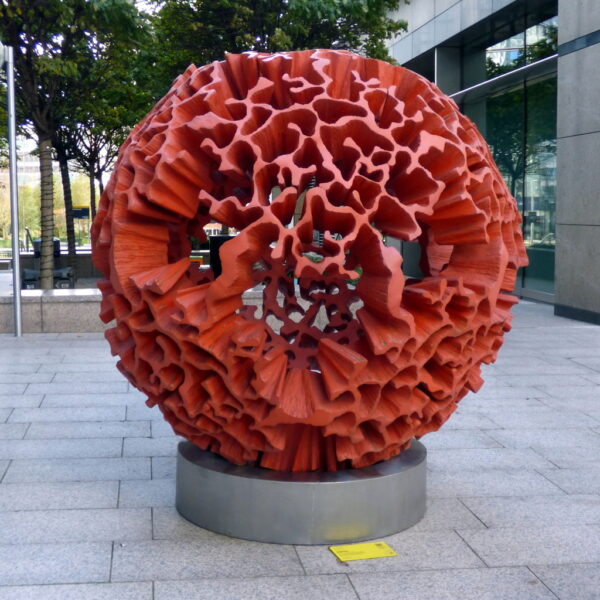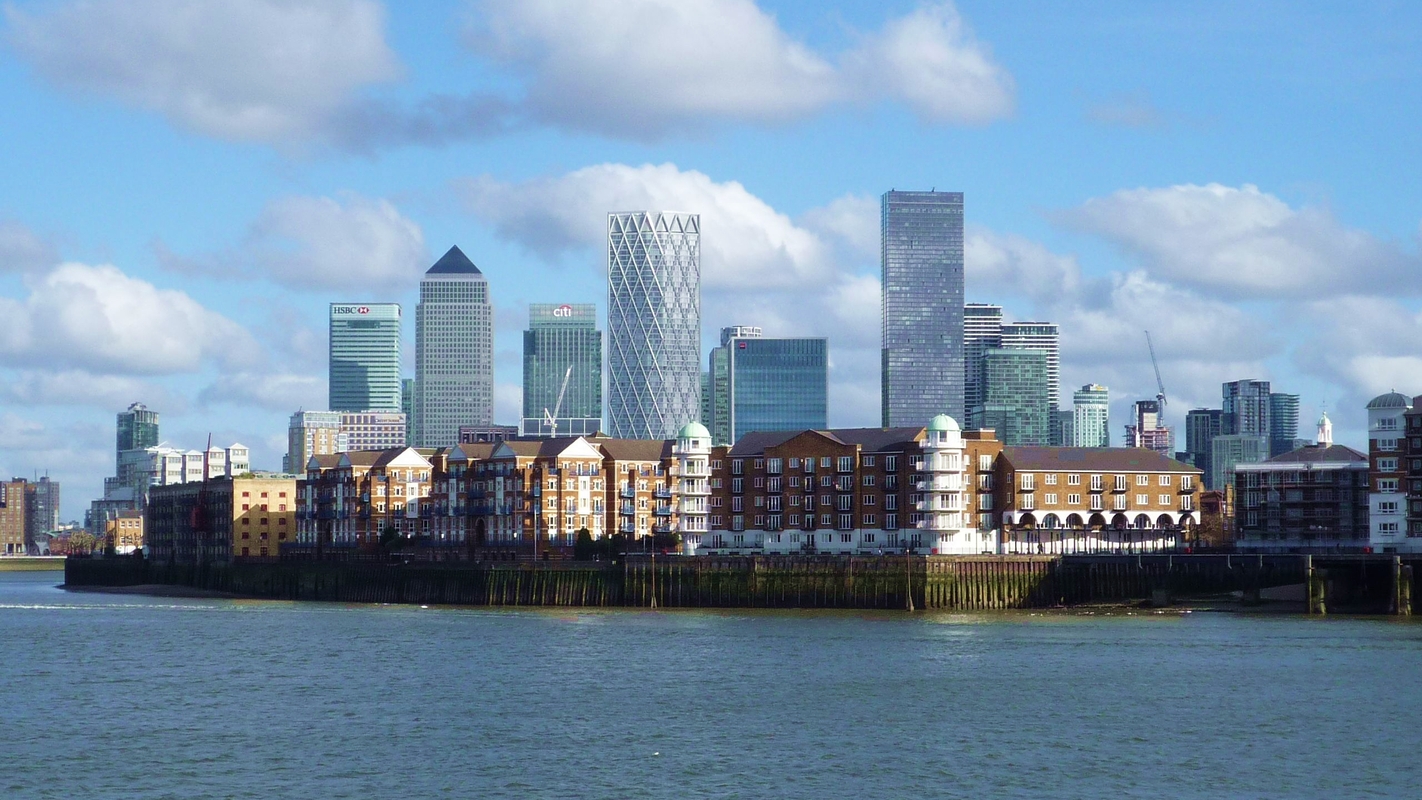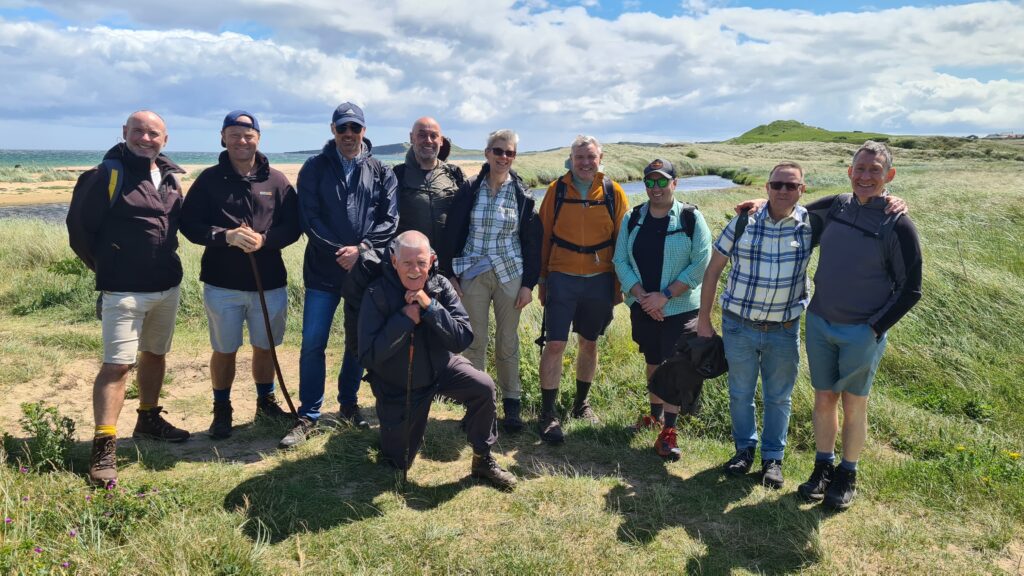Event led and researched by John T.
Attendance: 28 people.
Distance: 8.37 miles (13.5 km).
Time: start 11:10, end 16:28, lunch 27 minutes, other breaks included in walk-time.
Speed: moving arithmetic average 1.73 mph (2.74 kph).
Terrain: pavement and road on footpath and highway.
Elevation: low <0m*, high 19m (as measured by GPS), start 8m.
* recorded by GPS. Lowest elevation underneath the Thames, probably -15m, but the GPS cannot measure this.
Weather: ideal walking weather, sunny intervals, range between 10°C and 11°C, max 6mph westerly wind.
Number of sewage works: 0.
Number of churches: 2.
Number of golf courses: 0.
Target number of public works of art: 71. Maximum possible number: pffft.
This walk was a point-to-point route of 8.37 miles from Jubilee Plaza, Canary Wharf to Greenwich, via an expanding clockwise spiral around Canary Wharf then W to the Thames, S alongside the western edge of the Isle of Dogs, S under the Thames, E, S & W around the Greenwich palace complex, into Greenwich.
Walk leader John undertook his customary due diligence on researching works of art hidden in plain public sight, for which we are extremely grateful. It takes a lot of time to research what is available, what route best fits artworks, and whether the artworks are still likely to be there on the day of the walk. For this walk, the target list was seventy-one works of art.
The weather was excellent for an art walk, with mainly sunshine throughout the day offering the optimum light to see the art.
The majority of the artworks on this walk were around the Canary Wharf area. The website for Canary Wharf (link below) lists all of the installed works. There are many more artworks than we had time to see on this walk.
The artworks themselves were a mixture of forms, textures, colours, materials and intrigue. The artworks included paintwork on the side of a bridge, a bridge itself, animated walls, a reclining metal doughnut, cold metal twisted into warm shapes, sculptured forms that appear to defy physics, rooftop gardens, big mirrored balls, glass friezes, a traditional archway and a model ship in a large glass bottle. One artwork was rather surreally thought-provoking not to see: it was an invisible statue, having been removed because of some connection to slavery. Is the removal a way to repeat the past in the future by trying hard to forget the past we know about today? Is art political? Or is politics art?
Three artworks are noteworthy. “Transitions”, by Michal Rovner, is a large screen of partly-fixed images overlaid by partly-animated imagery, on a backdrop of changing colours and obscurities. The art shows a pastiche view of London, pertaining from the east looking westbound, with a view of familiar landmark buildings in the background, parks in the middle-ground (with pedestrians walking their dogs, or a family day out) and an anthropocentric representation of transit systems, each light representing a passenger, some walking (as if in a tube station) and some whizzing by (as if standing on a fast packed commuter train). Every now and then, some of the passengers turned red, we weren’t quite sure what the red meant. The transitions themselves characterise travel patterns during the day and the evening, co-ordinated with the change in lighting, from day to night, from clear weather to London fog. Opposite “Transitions” is “Infinity Bench”, a functional artwork that provides a bench for people to watch “Transitions”. One art for the eyes; one art for the backside. Both are at Crossrail Place, near Adam’s Plaza, Everyman Cinema Lobby (interior).
The third noteworthy artwork is “Skystation”, by Peter Newman. This is metal seating, polished as gold, arranged as a circle. The idea is that people can lay back in the artwork to watch the clouds interact with the buildings. Lying on bare metal in the middle of November means it’s cold. Really cold. Chilled-to-the-bone-cold. Presumably, in summer, users of the artworks are fried. The art is at Adam’s Plaza.
Not listed as public artworks are the buildings of Canary Wharf itself. The architecture of the area is both simultaneously uniform and diverse. Uniform, in that nearly all of the buildings are tall vertical structures of glass and concrete. Diverse, in that the arrangement of materials created various shapes and textures (ranging from forms of 1970s brutalism wrapped in 1990s soft-tone pseudo-marble, to residential studio boxes stacked up like a vertical pincushion). The area feels very corporate, as expected given its history, but not entirely soulless. Similar to Toronto City, Canada, life is in underground shopping malls. Yet, individual buildings have distinctive quirks, trying to different whilst trying to conform to the corporatocracy: one building provided a mirrored ceiling, which became an impromptu group shot (see links below), with lots of opportunity for neckache.
One surprise was the sheer number of people milling around the place. On the pavement around Canary Wharf, we encountered few people, but the shopping malls (Cabot Place, Canada Place, Jubilee Place) were packed with both artworks and people. This suggested that not only are the residents of Canary Wharf out-and-about, but that the malls attract visitors from neighbouring boroughs.
Security was ever-present. Every 200 metres or so, there was a security guard watching the world go by. As a group of 28 being led by one man holding up a bright pink umbrella in the middle of a sunny day, doubtless the security operatives had all sorts of questions racing through their minds. At the rooftop garden, one security guard even asked us what we were doing! This was probably the normal level of security for the Docklands corporate area, but it ought be noted that this particular 11 November 2023, Armistice Day, was also a day of protest in Westminster relating to the scuffles then taking place in Israel & Gaza. Good security personnel need to be paranoid.
Canary Wharf also gave us the sight of… well… what can only be described as “first world problems”. Unbelievably hypocritically, in this world of banned wood burning stoves (carbon emissions!), some wag has thought of barbecues-in-a-boat (fire risk!) and… wait for it… jacuzzi-in-a-boat (bare flesh in public! In November!!). Seriously. Does this absurdity count as performance art? The way the jacuzzists were failing to pilot the boat around the docks – over-steering, so bumping off the dockside – certainly counted as a performance of some sort. In addition, the jacuzzists were also each holding a smartphone filming each other. So… all of them in swimming costumes, in November, each holding up their smartphone – their primarily token of mandatory digital identity, their virtual payment card, their virtual Oyster card, their security device to get into their office, devices not known for being particularly waterproof – limply over a jacuzzi, itself a boat floating on a dock, bumping into dock walls. Yep… that’s art.
The route alongside the Thames was simply glorious, with sunshine through the route. This part of the Thames is well developed, with mainly medium-rise residential buildings looking over the river, resulting in a quiet, pleasant walk.
Greenwich was absolutely heaving with people in all parts of our route. Having emerged from the Greenwich tunnel, a mob of people milled around the Cutty Sark (1869). We visited the Chapel of St Peter & St Paul, a navy chapel, thus visiting our customary church and seeing more traditional artworks inside. As the light faded, we caught a glimpse of a model boat in the bottle (“Nelson’s Ship in a Bottle”, by Yinka Shonibare), the final rays of the sun bringing out the colours in the boat’s sails.
14 members joined the optional pub stop at the end of the walk.
Names of artworks in pictures in this event report:
- “Coquino Coral” by Yvonne Domenge, 2015 (orange coral-like ball thing).
- “Two Men on a Bench” by Giles Penny, 1995 (described as named).
- “Centurione I” by Igor Mitoraj, 1987 (large mask of metal with top of head missing)
- “Draped Seated Woman” by Henry Moore, 1957-58 (described as named)
- “Kiss” by Nigel Hall, 2000 (two red shapes, a triangular prism and a cone, nearly touching eachother).
- In the banner pic, “Metamorphosis” by Helaine Blumenfeld, 2019 (group shot).
See links below for more pics.
Churches:
- St Edmund’s Roman Catholic church, Westferry Road, Isle of Dogs, London.
- The Chapel of St Peter & St Paul, Greenwich (also).
Optional pub stop
- The Mitre, Greenwich
External links:
Words by Martin Thornhill. Pictures by Peter O’Connor.
